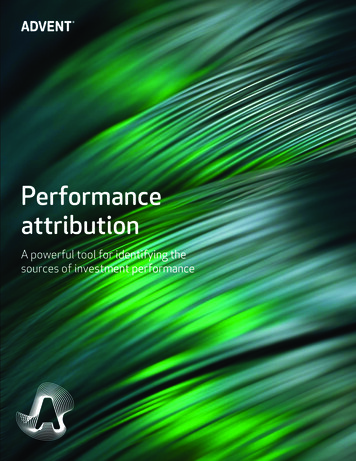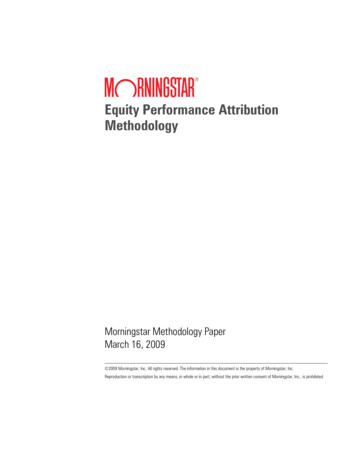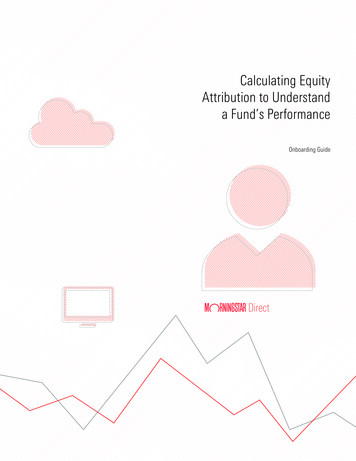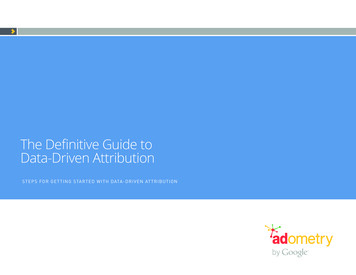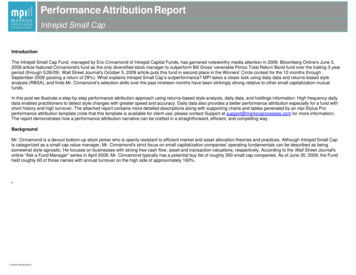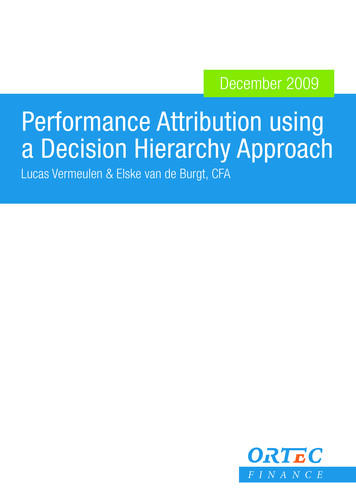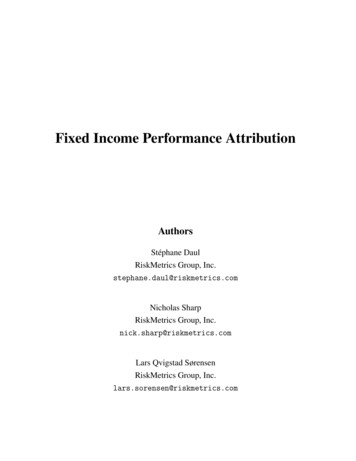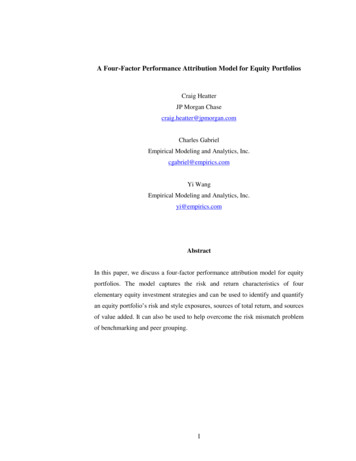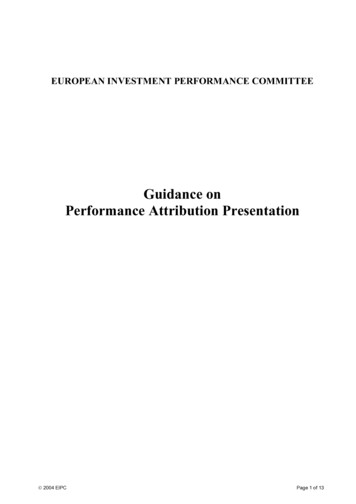
Transcription
EUROPEAN INVESTMENT PERFORMANCE COMMITTEEGuidance onPerformance Attribution Presentation 2004 EIPCPage 1 of 13
EUROPEAN INVESTMENT PERFORMANCE COMMITTEEGuidance on Performance Attribution PresentationSection 1 – IntroductionPerformance attribution has become an increasingly valuable tool not only for assessing asset managers’skills and for identifying the sources of value added but also for facilitating a meaningful dialogue betweeninvestment managers and their clients.Like any other performance presentation, a presentation of performance attribution results providesmeaningful information to the user only to the extent the user understands the assumptions and conceptsunderlying this presentation. That’s why it is crucially important that the presentation of attribution results isprovided in a way that does not mislead the users and contains all necessary disclosures to explain theunderlying assumptions and concepts.Given the aforementioned, the European Investment Performance Committee (EIPC) has decided to take theinitiative and to address the demand of the investment management industry for specific guidance withrespect to presentation of return and risk attribution analysis. The first step was the issue of the EIPCWorking Paper „Guidance for Users of Attribution Analysis“ in early 2002. The following Guidance onPerformance Attribution Presentation represents the next milestone in this process and establishes a reportingframework, which provides for a fair presentation of return and risk attribution results with full disclosure.EIPC acknowledges that this Guidance is not the final step in this process and will have to be developedfurther to address any new matters arising in future.Except for definition of some general terminology, the Guidance does not address methodological issueswith respect to calculation of attribution results, nor attempts to present any prescriptive definitions. EIPCbelieves that setting any standard on performance attribution should primarily contribute to increasing theunderstanding of attribution through the necessary disclosures and transparency of the methodology andinvestment process. For details on various performance attribution methods and concepts, users should referto the dedicated performance literature available. Being a “disclosure guidance”, the Guidance can begenerally applied to all types of investment portfolios (equity, fixed income or balanced).The Guidance does not require investment managers to present return and risk attribution results. However,if investment managers do present attribution analysis, they are encouraged to provide full disclosure and toapply the provisions of the Guidance. As the importance of a particular piece of information may varydepending on the situation, EIPC believes that differentiation in the disclosures between required andrecommended may be too subjective.EIPC regards it as the responsibility of users of performance attribution to duly inform themselves aboutperformance attribution concepts and, when presented with performance attribution results, to ask relevantquestions to understand the underlying assumptions and methods. Not doing this may lead tomisinterpretations and misjudgment of the quality of investment managers presenting the attribution results.The Guidance was approved by EIPC in January 2004. EIPC proposes that this Guidance be adopted by theInvestment Performance Council (IPC) as a guidance for the investment management industry. 2004 EIPCPage 2 of 13
EUROPEAN INVESTMENT PERFORMANCE COMMITTEEGuidance on Performance Attribution PresentationSection 2 – DefinitionsThe purpose of the following definitions is to provide the user with an explanation on the terminology as it isused in this Guidance. The Guidance does not attempt to establish any absolute or dogmatic definitions andrecognises that there may be various views and interpretations of these matters within the investmentmanagement industry.Performance Attribution:1) Performance attribution techniques are generally understood as a processof decomposition of return and risk into the investment managementdecisions in order to measure the value added by active investmentmanagement and to communicate the risk components of the investmentstrategy.2) For the purposes of this Guidance term “Performance Attribution” refersboth to attribution of historic returns and to risk attribution (ex-ante and expost). The Guidance emphasises the distinction between return and risk andencourages the view of performance as a combination of risk and return. Asa rule, terms “Return attribution” and “Risk attribution” are explicitly usedin this Guidance.Excess / Active Return:The difference between a periodic portfolio return and its benchmark return.This value may be calculated either as an arithmetic or a geometricdifference. Also called relative return.Return Attribution:1) Return attribution techniques are generally understood as a process ofdecomposition of active (historic) returns into the investment managementdecisions in order to identify the sources of return.2) Return attribution can be applied to absolute returns (absolute attribution)or to relative / excess returns, being the difference between the portfolio andbenchmark return (relative attribution).Return Contribution:Return contribution techniques are generally understood as a process ofdecomposition of returns in order to measure the contribution of eachparticular segment of the portfolio to the portfolio overall return.Risk Attribution:For the purpose of this Guidance, the following elements of risk attributionanalysis are defined:Risk measurement:The process of measurement of a portfolio’s risk in absolute (e.g. volatility,value-at-risk) or relative (e.g. tracking error) terms, both ex-post (historic)and ex-ante (predicted).Risk attribution:The first step of risk attribution is the risk decomposition, i.e. identifying thesources of a portfolio’s risk, both ex-post (historic) and ex-ante (predicted),both in absolute terms and relative to the selected benchmark. This processmay include decomposition into sources of systematic and specific risk orinto various factors (e.g. industry, style, country, currency, credit quality,etc.) affecting a portfolio’s risk; as well as determination of contribution ofindividual securities to the overall portfolio risk.The further step of risk attribution is the process of measurement ofcontribution of investment management decisions to the active portfolio risk(e.g. to the portfolio tracking error).Risk attribution for the purposes of this Guidance only refers to the analysisof investment risk and not to operational or other types of business risks. 2004 EIPCPage 3 of 13
EUROPEAN INVESTMENT PERFORMANCE COMMITTEEGuidance on Performance Attribution PresentationSection 3 – Guiding principlesInvestment managers are required to apply the following principles when calculating and presenting returnand risk attribution results: Return and risk attribution analysis must follow the investment decision process of the investmentmanager and measure the impact of active management decisions. It is essential that the attributionanalysis reflects the actual decisions made by the investment manager. Return and risk attributionanalysis must mirror the investment style of the investment manager. For the attribution of relative return and risk, a benchmark appropriate to the investment strategy mustbe used. The employed benchmark should be specified in advance and meet such criteria asinvestability, transparency and measurability. If investment managers are not able to produce return and risk attribution results that comply with theabove guiding principles, they still may use these results for internal purposes but should refrain frompresenting attribution to external users or use it for the purposes of soliciting potential clients.Section 4 – DisclosuresA. Return AttributionThe following disclosures are required to be provided, as long as they are applicable, when presenting returnattribution results.A.1. Investment ProcessA.1.1 Object of a returnattribution analysisFirms must disclose the object of a return attribution analysis, e.g. aparticular portfolio, a representative portfolio, a model portfolio, agroup of portfolios (composite), etc., and the reasons for selecting thisparticular object.A.1.2 Investment managementprocess and investmentstyleFirms must disclose the main elements of their investmentmanagement process, including the key investment decision factorsemployed.A.1.3 BenchmarkFirms must disclose the composition of the benchmark used for thereturn attribution purposes. Benchmark rebalancing rules must also bedisclosed. If there has been any change in benchmark, the oldbenchmark(s) and date(s) of change(s) are to be disclosed.In case of investments outside of the scope of the benchmark, firmsmust disclose the treatment of the impact of these investments, e.g.allocated to another attribution effect, presented separately, etc.If the attribution is not based on a benchmark, firms must disclose therationale for this. 2004 EIPCPage 4 of 13
EUROPEAN INVESTMENT PERFORMANCE COMMITTEEGuidance on Performance Attribution PresentationA.2. Return Attribution ModelA.2.1Return attribution modeland attribution effectsFirms must disclose a description of the return attribution model1.Attribution effects derived (e.g. depending on the portfolio type:timing, security selection, currency effects, or income, duration,spread effects, etc.) must be clearly identified.If the attribution model has changed during the period of analysis,these changes and the rationale for them must be disclosed. Inaddition, the implications for the attribution history, if any, as a resultof this change must be disclosed.A.2.2Excess / active returnsFirms must disclose whether periodic excess returns are derived usingan arithmetic or a geometric method.A.2.3Presentation periodFirms must disclose what time period the attribution analysis coversand why this period has been chosen.A.2.4Frequency of returnattribution analysisFirms must disclose the frequency of calculation of attribution effects(e.g. daily, monthly basis, etc.).A.2.5Linking methodologyIf the attribution report provides effects which were calculated forsubperiods (e.g., days) and linked to present results for longer periods(e.g., a month), then the details of the linking methodology must bemade available upon request. If a smoothing algorithm has beenemployed to allocate in a systematic way residual effects over time,the type of this algorithm is to be disclosed.A.2.6Buy-and-hold vs.transaction based approachFirms must disclose whether the return attribution approach is buyand-hold or transaction based.A.2.7Interaction effect and/orunexplained residualsSome attribution models generate interaction effects or evenunexplained residuals. Unexplained residuals may impair the qualityof analysis and conclusions that may be drawn from it. If the modelhas an interaction term or an unexplained residual, details of itstreatment must be disclosed, e.g. presented separately, ignored,allocated to other attribution effects, etc.A.2.8DerivativesFirms must disclose to what extent derivatives are included and howthey are treated in the return attribution analysis.A.2.9Effect of leverageIf leverage is employed, firms must disclose how leverage effects areattributed according to investment decision process.A.2.10 Foreign currency effectsIf investments in currencies other than the base currency of theportfolio are employed, treatment of foreign currency effects in termsof the currency management strategy must be disclosed.A.2.11 Inclusion of cashFirms must disclose whether cash is specifically included in theattribution analysis and whether a cash benchmark is determined.Firms also must disclose any difference in treatment of strategic cashallocation positions vs. temporary cash from realised income.1If the model is one which has been documented in an industry publication, its name and source reference must be disclosed. If themodel is a variation of a published model, the original name and source reference must be disclosed, as well as an explanation of therevisions which have been made. If the model is unpublished or proprietary, then a broad description of its details must be disclosed. 2004 EIPCPage 5 of 13
EUROPEAN INVESTMENT PERFORMANCE COMMITTEEGuidance on Performance Attribution PresentationA.2.12 Transaction costs, feesFirms must disclose the treatment of the impact of transaction costs,fees, etc. - e.g. allocated to a particular attribution effect, presentedseparately, etc.A.3. Underlying input dataA.3.1 Portfolio returnsFirms must disclose: methodology and frequency of calculation of portfolio andportfolio segment returns, treatment of single performance components, such as managementfees, custodian fees, taxes and transaction costs (gross vs. nettreatment).A.3.2 Benchmark returnsFirms must disclose: methodology of calculation of benchmark returns, any adjustments with respect to management fees, realised incomepositions, taxes etc., source of data.Firms are encouraged to disclose any other specific details that may beimportant.A.3.3 Leveraged portfoliosIf the underlying portfolio includes discretionary leverage, the firmmust disclose whether calculation of portfolio returns is performed onan actual or “all-cash” basis2.A.3.4 Underlying valuation dataFirms must disclose if there are any differences with respect to sourcesand timing of prices of underlying securities between the portfolio andthe benchmark.A.3.5 Foreign exchange ratesFirms must disclose if the sources or timing of foreign exchange ratesare different between the portfolio and the benchmark.A.3.6 Income positionsFirms must disclose if realised income from dividends and coupons isconsidered after or before deduction of applicable withholding taxesboth for the portfolio and the benchmark.Firms are encouraged to disclose any additional matters they find useful or relevant for the users ofattribution analysis.2For details regarding „all-cash“ basis calculations refer, for example, to AIMR-PPS Handbook, 1997, App. B, p. 117 2004 EIPCPage 6 of 13
EUROPEAN INVESTMENT PERFORMANCE COMMITTEEGuidance on Performance Attribution PresentationB. Risk AttributionThe following disclosures are required to be provided when presenting risk attribution analysis results.B.1. Investment ProcessB.1.1 Object of risk attributionFirms must disclose the object of risk analysis, e.g. a particularportfolio, a representative portfolio, a model portfolio, a group ofportfolios (composite), and the reasons for selecting this particularobject.B.1.2 Investment managementprocess and investmentstyleFirms must disclose the main elements of their investmentmanagement process, including the key investment decision factorsemployed.B.1.3 BenchmarkFirms must disclose the composition of the benchmarks used for therisk attribution purposes. Benchmark rebalancing rules must also bedisclosed. If there has been any change in benchmark, the oldbenchmark(s) and date(s) of change(s) are to be disclosed.In case of investments outside of the scope or profile of thebenchmark, firms must disclose the treatment of the impact of theseinvestments.If the attribution is not based on a benchmark, firms must disclose therationale for this.In case risk attribution is presented together with return attribution, thesame benchmark as for return attribution should be used. If a differentbenchmark is used, the rationale for this must be disclosed.B.2. Risk Attribution ModelB.2.1Risk attribution model andattribution factors.Firms must disclose a general description of the risk attribution model,including description of the presented risk measures3 and riskdecomposition factors.If the risk attribution model has changed during the period of analysis,these changes and the rationale for them are to be disclosed. Inaddition, the implications for the analysis history, if any, as a result ofthis change must be disclosed.The risk attribution should, where possible, involve both ex-post andex-ante analysis. This should also involve a reconciliation of the expost and ex-ante measures in order to assess the validity of the model.B.2.2Ex-ante risk measuresWhen presenting forward-looking risk measures, firms must provide abroad description with respect to the methods used to estimateportfolio holdings and/or likely magnitudes of relative returns forindividual securities, sectors or markets and their correlation with eachother.3If the model is one which has been documented in an industry publication, its name and source reference must be disclosed. If themodel is a variation of a published model, the original name and source reference must be disclosed, as well as an explanation of therevisions which have been made. If the model is unpublished or proprietary, then a broad description of its details must be disclosed. 2004 EIPCPage 7 of 13
EUROPEAN INVESTMENT PERFORMANCE COMMITTEEGuidance on Performance Attribution PresentationFirms must also disclose the impact of the portfolio turnover and howthis would influence their assumption regarding stability of the futureportfolio asset structure.B.2.3Analysis periodWhen presenting risk measures, firms must disclose the reporting dateof the analysis.When presenting backward-looking risk measures, firms must disclosewhat time period the analysis covers and why this period has beenchosen. In case ex-post risk attribution is presented together withreturn attribution, the analysis period should be the same as for thereturn attribution.B.3. Underlying input dataB.3.1 Portfolio returnsFirms must disclose: methodology and frequency of calculation of portfolio and segmentreturns, treatment of single performance components, such as managementfees, custodian fees, taxes, external cash flows and transactioncosts (gross vs. net treatment).B.3.2 Benchmark returnsFirms must disclose: methodology of calculation of benchmark returns, any adjustments with respect to management fees, realised incomepositions, taxes, etc., source of data.Firms are encouraged to disclose any other specific details that may beimportant.B.3.3 Leveraged portfoliosIf the underlying portfolio includes discretionary leverage, the firmmust disclose whether calculation of portfolio returns is performed onan actual or “all-cash” basis4.B.3.4 Underlying valuation dataFirms must disclose if there are any differences with respect to sourcesand timing of prices of underlying securities and foreign exchangerates between the portfolio and the benchmark.B.3.5 Foreign exchange ratesFirms must disclose if the sources or timing of foreign exchange ratesare different between the portfolio and the benchmark.B.3.6 Income positionsFirms must disclose if realised income from dividends and coupons isconsidered after or before deduction of applicable withholding taxes.Firms are encouraged to disclose any additional matters they find useful or relevant for the users ofattribution analysis.4For details regarding „all-cash“ basis calculations refer, for example, to AIMR-PPS Handbook, 1997, App. B, p. 117 2004 EIPCPage 8 of 13
EUROPEAN INVESTMENT PERFORMANCE COMMITTEEGuidance on Performance Attribution PresentationSection 5 – Relation to the Global Investment Performance Standards (GIPS )EIPC does not currently view this Guidance as a part of the Global Investment Performance Standards(GIPS ) compliance framework. However, the Guidance can obviously be considered as a part of a broaderethical code of conduct for investment managers. Firms claiming GIPS compliance and presentingperformance attribution analysis are encouraged to follow this Guidance. However, users should be awarethat some GIPS requirements may not always be applicable for attribution analysis purposes, e.g. returncalculation methods for individual client reporting.Attribution analysis results may also be presented as a supplemental information to a GIPS compliantperformance presentation. If attribution analysis is presented as a part of a GIPS compliant performancepresentation, users should also refer to the GIPS Guidance Statement on the Use of SupplementalInformation for guidance. 2004 EIPCPage 9 of 13
EUROPEAN INVESTMENT PERFORMANCE COMMITTEEGuidance on Performance Attribution PresentationAppendix 1 – Example of return and risk attribution report in compliance with this GuidanceThe following sample attribution analysis report refers to an equity portfolio and is an example of how aperformance attribution presentation in compliance with this Guidance could look like. This sample report isabsolutely not intended to serve as a “best practice” benchmark to present performance attribution in termsof methodology or layout.Investment Manager ABCReturn Attribution and Risk Attribution Report for Equity Portfolio XYZ as of 31.03.2001Return and Risk Attribution Report for:Period:PORTFOLIO XYZ.1.1.2000 - 30.03.2001Reference Currency:EURBenchmark:Customised (refer to Disclosures)ReturnSector OverweightsPortfolio-4.45%Other AssetsBenchmark-2.89%UtilitiesActive (Relative) Return-1.56%Return Attribution Analysisby Industry SectorResourcesNon Cyclical ServicesNon Cyclical Cons GoodsInformation TechGeneral IndustriesFinanceCyclical Consumer GoodsBasic 0.0%0.2%0.4%-0.25%Total-1.56%Asset Allocation0.09%Stock Selection-2.74%Other Effect1.09%Total-1.56%PortfolioBenchmarkNumber of Securities99576Number of Currencies22TotalPortfolio ValueOther AssetsTotal Risk (ex-ante)15.76%15.31%- Factor Specific Risk15.53%15.20%UtilitiesResourcesNon Cyclical ServicesNon Cyclical Cons GoodsInformation TechGeneral Industries227'447'728- Style4.91%4.29%- Industry11.95%11.80%- Stock Selection Risk2.72%1.83%Tracking Error (ex-post)2.29%Tracking Error (ex-ante)2.35%Cyclical ServicesValue at Risk (at 97.7%)10'878'425Cyclical Consumer GoodsR-squaredBasic IndustriesBeta-adjusted RiskFinanceAsset Allocation-0.52%Other EffectRisk Analysis(end of period)Attribution Analysis by Industry Sector-1.0%-0.79%Stock SelectionReturn Attribution Analysisby RegionCyclical Services-4.0% -3.0% -2.0% -1.0% 0.0%Asset AllocationStock Selection0.9815.59%Predicted Beta1.02Predicted Dividend Yield2.2215.31%2.37Attribution Analysis by Region1.0%0.5%0.0%-0.5%-1.0%-1.5%-2.0%-2.5%-3.0%t plgartuPoayrwNogurbodslanerethN 2004 ukarmenDmiulgBeatriusAAsset AllocationStock SelectionPage 10 of 13
EUROPEAN INVESTMENT PERFORMANCE COMMITTEEGuidance on Performance Attribution PresentationDisclosuresInvestment ProcessObject of the attributionanalysis:The return and risk attribution analysis is performed for Portfolio XYZ as anintegral part of the periodic client reporting to company XYZ.Investment managementprocess and investmentstyle:Portfolio XYZ is a discretionary equity mandate with reference currency EURmanaged in an active way against the customised benchmark specified bycompany XYZ as described below. In addition, the following specific clientguidelines apply: outperform the defined benchmark (basis EUR) by 2% p.a.over a rolling 2-year period with a tracking error of max. 3% p.a.Investment Manager ABC applies a top-down investment approach by activelymodifying the portfolio asset allocation and taking active decisions withrespect to stock selection. Foreign currency positions are not actively hedged.The inception date of portfolio XYZ is 1.1.2000.Benchmark:The benchmark for portfolio XYZ is given as follows:EUR Cash Index Z:5%EUR Stock Index X60%World Stock Index Y35%A monthly rebalancing is applied.Results from investments in single stocks outside of the scope of thebenchmark are allocated to the stock selection effect.There were no changes in the benchmark since inception of the mandate.Attribution ModelReturn attribution model:Return attribution is performed under the Brinson-Fachler method. Details andexplanations to this model are available upon request. Returns are attributed toasset allocation (timing) and stock selection effects and presented according tothe industry sector and region. Please refer also to disclosure “Interaction effectand/or unexplained residuals”.There has been no change in the model since inception of the portfolio.Excess / active returns:Periodic excess returns are derived using an arithmetic method.Presentation Period:The return attribution and risk attribution analyses cover the period from1.1.2000 to 31.03.2001 and is performed within the regular quarterly sinceinception reporting.Frequency of returnattribution analysis:The attribution effects are calculated on a monthly basisLinking methodology:The monthly attribution effects are multiplicatively linked to show theattribution results for the whole presentation period. No smoothing algorithmsare employed to systematically allocate the residual effects over time. Detailson the methodology are available upon request. 2004 EIPCPage 11 of 13
EUROPEAN INVESTMENT PERFORMANCE COMMITTEEGuidance on Performance Attribution PresentationTreatment of transactions:The return attribution model is based on a “buy-and-hold” approach. However,as transactions in the portfolio usually occur at the beginning of the month andthe attribution effects are calculated on a monthly basis, porttolio managerABC believes that potential distortions should be minimal.Interaction effect and/orunexplained residuals:The model generates a residual effect due to multiplicative linking ofarithmetically derived attribution effects over time. This effect is presentedseparately as “Other effect”.The model does not generate any other unexplained residuals.Derivatives:Derivatives are not employed in this portfolio.Use of leverage:Leverage is not employed in this portfolio.Inclusion of cash:According to the defined portfolio benchmark, cash represents a strategicposition and is specifically included in the attribution analysis against aspecified cash benchmark index. There is no difference in treatment of thestrategic cash allocation position comparing to temporary cash from realisedincome as the realised income cash is deemed to be immaterial.Foreign currency positions:Foreign currency positions are not hedged into the portfolio reference currency.Foreign exchange effects of these positions are included in the returnattribution analysis within the stock selection effect.Transaction costs and fees:Returns are calculated net of transaction costs and gross of fees. The impact oftransaction costs vis-à-vis the benchmark return is not calculated specifically asthe model is not transaction based. The model implicitly includes transactioncosts on a cash level.Risk attribution analysisThe presented risk attribution analysis includes both ex-post and ex-ante riskmeasurement and risk decomposition.Ex-post analysis includes calculation of the historical annualised tracking error.Ex-ante analysis includes calculation of the predicted total risk of the portfolio(annualised volatility) and its decomposition into factor-specific (style andindustry) and stock selection components. In addition ex-ante annualisedtracking error and value-at-risk (VaR) measures are presented. The predictedVaR measure is calculated on the basis of the parametric (variance/covariance)method.The methodology and assumptions used for calculation of ex-ante (predicted)risk measures are developed and implemented in the proprietary model ofcompany WWW, broad details of which are available upon request. For thepurposes of the ex-ante risk analysis, an assumption is taken that the portfoliostrategic asset structure remains stable (with monthly rebalancing) over time.While reasonable care is exercised when predicting risk parameters, users ofthis report should be aware of inherent limitations of such forecast methods aswell as of the assumptions underlying the calculation of risk measures (such asnormality of return distributions, etc.).A periodic reconciliation of the ex-post and ex-ante measures is performed ona quarterly basis to assess the model risk. The historic reconciliation results(since portfolio inception) show that an average model error lies within thebandwidth of 200-300 b.p. 2004 EIPCPage 12 of 13
EUROPEAN INVESTMENT PERFORMANCE COMMITTEEGuidance on Performance Attribution PresentationUnderlying input dataUnderlying portfolioreturns:The underlying portfolio returns are calculated in EUR on a montly basisaccording to the true time-weighted rate of return method and under applicationof the total-return concept. Returns are calculated net of transaction costs andwithholding taxes on interest and dividend income and gross of managementand custodian fees.The underlying portfolio data are derived from the accounting records ofInvestment Manager ABC. The source of securities prices and foreignexchange rates is data provider ZZZ.Benchmark returns: 2004 EIPCThe underlying benchmark returns are calculated on a monthly basis underapplication of the total-return concept and monthly rebalancing. Thebenchmarks returns are calculated on the basis of EUR as reference currency.The source of the benchmark data is data provider ZZZ.Page 13 of 13
Performance Attribution: 1) Performance attribution techniques are generally understood as a process of decomposition of return and risk into the investment management decisions in order to measure the value added by active investment management and to communicate the risk components of the investment strategy.
